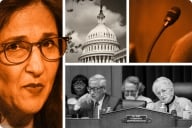You have /5 articles left.
Sign up for a free account or log in.
TORONTO -- Has the rising cost of college reached a tipping point?
Perhaps not, said three panelists at the National Association of College Admissions Counselors’ annual conference in here last week. They offered their analysis at a meeting where many private college officials were very worried their sticker prices are scaring away would-be students.
Steven Graff, senior director of admissions and enrollment services at the College Board, said it’s become “knee jerk” to say college is too costly.
“But,” he said, “what I think we have to do is move away from the monolithic assumption that the word ‘college,’ the word ‘price,’ the word ‘cost’ are the same for every student, every institution, for every situation we are dealing with.”
Instead, the panel argued, college prices and costs require a more nuanced view than the one offered by most in the media or perhaps even by President Obama, who last month went on a campaign-style tour to tout his plan to curb college costs.
Graff and two consultants from the enrollment management firm Art & Science Group argued that there is a significant difference between college cost and college price, in part because of financial aid, and there are also rather significant differences among prices at different kinds of institutions.
They did not dismiss the woes that have hit lower- and middle-class families whose buying power has remained flat or declined in recent decades, even as prices have risen.
“This divergence is beginning to play a larger part,” Graff said.
But he said most commentary on college costs has been skewed by generalizations or by anecdotes of high sticker prices and debt that then get turned into generalizations.
Citing College Board data, Graff said even though college costs have risen, the shift has not been dramatic across the board.
Instead, high-priced for-profit colleges have enrolled an increasing numbers of students, and they charge more for degrees than do public colleges. According to College Board data, about 75 percent of public four-year students see tuition and fee price tags of $12,000 or less to attend college, while roughly two-thirds of for-profit students see price tags of $12,000 or more.
While public four-years have arguably been able to keep prices relatively low measured this way, the attention-grabbing price tags at private four-years are also notable for exaggerating actual cost. According to the College Board, published tuition and fees for private four-year colleges rose to $29,000 from $17,000 in the early-1990s in inflation-adjusted dollars, but the actual cost to families in 2012 dollars was about $13,000 in 2012, or just $3,000 more than it was in the early 1990s.
Graff also does not feel families are saving as much for college as they once did, part of a cultural shift that may be forcing students to take out loans, which is driving talk of a debt crisis for students.
“I don’t know that the family sees [itself] as being the primary source of funds for higher education -- the assumption is somebody else will pay a good portion of it,” he said.
Craig Goebel, a principal consultant at Art & Science Group, said the discussion about high college costs is not new.
Several decades ago, college officials worried that $10,000 tuitions would be a tipping point -- but that price point was blown past long ago.
He also said attempts to dramatically lower sticker prices may be ill-advised, at least at the institutions his firm has studied in detail. That’s in part because some families would rather see a high sticker price but receive generous aid.
Art & Science consultants have emphasized that price and cost are not the same
“We see in the research, that students react to price and aid as separate phenomena,” said Art & Science consultant Jamie Ealy.
He said enormous pressures have been brought to bear on colleges and families, including the sharp decline in state support for public colleges, endowment funds weakened by the recession and a growing division of wealth in America.
But Ealy said, “Ultimately cost is not the ultimate arbiter of enrollment decisions, not at all.” That’s because students pick a college for a variety of factors other than what is cheapest, including how they feel about the institution.
And, because of that, some dramatic efforts to lower the sticker price to drive up enrollment could backfire. In one institution the firm modeled, a hypothetical cut in prices would have required a 40 percent increase in enrollment to make up the lost revenue. At the same time, charging less to the students who can pay more leaves less aid money for the students who cannot pay more.
“Keeping your price lower, in effect, just makes it cheaper for the higher-income families to go there,” Goebel said.
Still, he said, there is one significant drawback to the high-tuition, high-aid model: high advertised prices -- which few students actually pay anyway -- have become an “easy straw man.”








